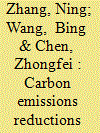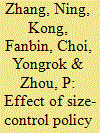| Srl | Item |
| 1 |
ID:
150887


|
|
|
|
|
| Summary/Abstract |
China's manufacturing industries are traditionally energy-intensive sectors and are responsible for over half of the country's total CO2 emissions. In this paper, we propose a global meta-frontier non-radial directional distance function approach to measure the CO2 emissions performance of Chinese manufacturing sectors during the period of 1990–2012. This approach allows us to simultaneously consider technological heterogeneity in manufacturing, non-radial slacks, and undesirable outputs. The global level of environmental technology is incorporated into the efficiency model to improve discriminating power and comparability. The results indicate significant differences in CO2-emissions-reduction performance among five broad groups of Chinese manufacturing industries. The “global technologies/ innovators group” is the most efficient under meta-frontier technologies, with the smallest technology gap. Meanwhile, the “energy-/resource-intensive commodities group” is, on average, the least efficient. Therefore, the Chinese government should implement targeted policies that encourage firms in the global technologies/innovators group to increase market share while supporting those in the energy-/resource-intensive commodities group to upgrade their technologies.
|
|
|
|
|
|
|
|
|
|
|
|
|
|
|
|
| 2 |
ID:
132770


|
|
|
|
|
| Publication |
2014.
|
| Summary/Abstract |
This paper examines the effect of size control policy on the energy and carbon efficiency for Chinese fossil fuel power industry. For this purpose, we propose two non-radial directional distance functions for energy/carbon efficiency analysis of fossil fuel electricity generation. One is named a total-factor directional distance function that incorporates the inefficiency of all input and output factors to measure the unified (operational and environmental) efficiency of fossil fuel power plants, and the other is called an energy-environmental directional distance function that can be used to measure the energy-environmental performance of fossil fuel electric power plants. Several standardized indicators for measuring unified efficiency and energy-environmental performance are derived from the two directional distance functions. An empirical study of 252 fossil fuel power plants in China is conducted by using the proposed approach. Our empirical results show that there exists a significant positive relationship between the plant size and unified efficiency, the five state-owned companies show lower unified efficiency and energy-environmental performance than other companies. It is suggested that Chinese government might need to consider private incentives and deregulation for its state-owned enterprises to improve their performance proactively.
|
|
|
|
|
|
|
|
|
|
|
|
|
|
|
|